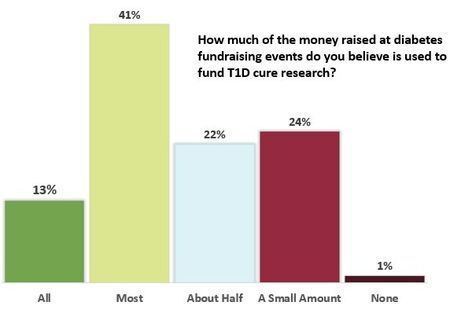
November 8, 2023
Every year, members of the T1D community rally together to participate in fundraising events to benefit diabetes nonprofits, contributing millions of dollars collectively every year. These are times of overflowing generosity, where individuals host or attend walks, rides, galas, and a number of other gatherings to positively impact diabetes-focused research and advocacy. Every dollar raised, step walked, and mile logged, is dedicated to the betterment of those impacted by the disease. Without this support, many developments in T1D research and treatment would not have been possible.
When money is donated and events are hosted, several questions are then posed: Where do participants want their thoughtful contributions to go? What is the primary reason individuals donate or participate in events?
This is the JDCA’s 12th year asking these questions to donors and fundraisers in the T1D community, to gain insight into what they value most. The survey was fielded to those who have participated in or donated to a T1D fundraising event within the past two years.
Key Findings
Virtual Attendance Remains Strong Even after COVID
At the start of the COVID pandemic, everything halted to a standstill—fundraising events included. Falling into suit with the rest of the world, these events either transitioned online or were cancelled altogether. Today, we see a lasting impact from the pandemic in the increase of all things virtual (work, education, social events, etc.).
This increased attendance is likely due to the rise of virtual options that greatly expand accessibility and convenience for donors who may otherwise be unable to attend these events.
47% (of 359 survey takers) in the T1D community who participated in the survey attended a fundraising event within the last two years (compared to 45% in 2022 and 40% in 2021).
42% (of 156 survey takers) attended a fundraising event virtually, with 19% reporting attendance at both virtual and in-person events.
Cure Research Is the Number One Priority

Following the trend of prior years, donors report that the primary reason they participate in events is to support cure research, a cause 94% consider to be extremely important. It’s for this very reason nonprofits utilize messaging in fundraising advertisements that imply proceeds will directly fund T1D cure research.
94% say that finding a cure is the most important reason they participated in a T1D fundraising event.
77% believe 100% of the money raised should go toward T1D cure research.
Nonprofits at Risk of Losing Donors Unless They Put More toward T1D Research

At the start of this survey, 76% of donors were under the impression that at least half of all money raised at fundraising events went to cure research.
We then asked donors questions pertaining to the JDRF and ADA, informing participants on how much the nonprofits spent on cure research in relation to total revenue in FY22.
The responses were straightforward, pointing to one conclusion: If the JDRF and the ADA don’t dedicate more funding to T1D cure research they risk losing donor support.
51% say they are less likely to donate or will stop participating altogether in JDRF events, after learning the nonprofit spent only 36% of its 2022 income on T1D research grants. Of those who answered “no change” to this question, 15% were not donating to the JDRF to begin with.
72% say they are less likely to donate or will stop participating in ADA events after learning the nonprofit gives less than 5% of its annual income to T1D research grants. Of those who answered “no change” in their likelihood of donating in the future, 91% were not donating to the ADA to begin with.
If Nonprofits Consider Donor Priorities, They Could See a Tidal Wave of Revitalized Funding
Some survey takers in the T1D community were discouraged—for others, it came as a shock—when discovering the amount JDRF and ADA, two prominent nonprofits, dedicated to T1D cure research.
However, respondents made it clear with their answers that if diabetes nonprofits expanded their research budget to at least half of the annual income, donations would skyrocket.
82% of donors are more likely to give/raise money for their T1D nonprofits if they grow their research budget to over half of their annual income.
One of the largest factors contributing to donations and the success of fundraisers is trust. Participants want to see the money they donate and raise put where they intend. If nonprofit institutions start aligning resource allocation with donor preferences, these organizations could see a massive increase in donations, allowing more funding to go exactly where donors want it: Practical Cure research.
79% of participants believe their T1D nonprofit should have a mechanism in place to collect and follow donor input when making research funding decisions.
